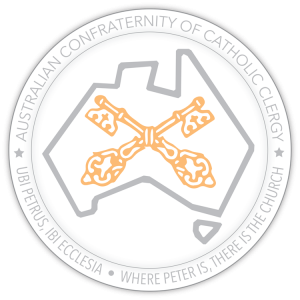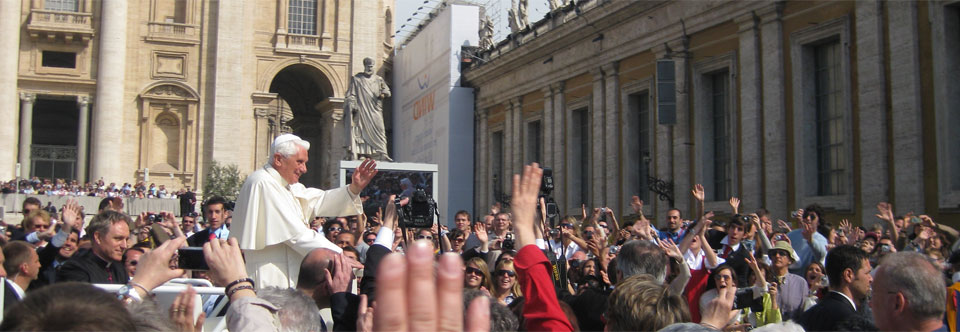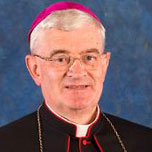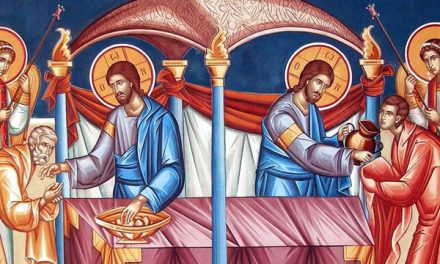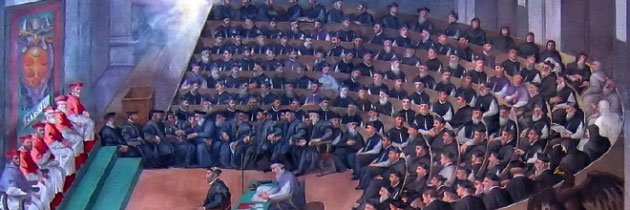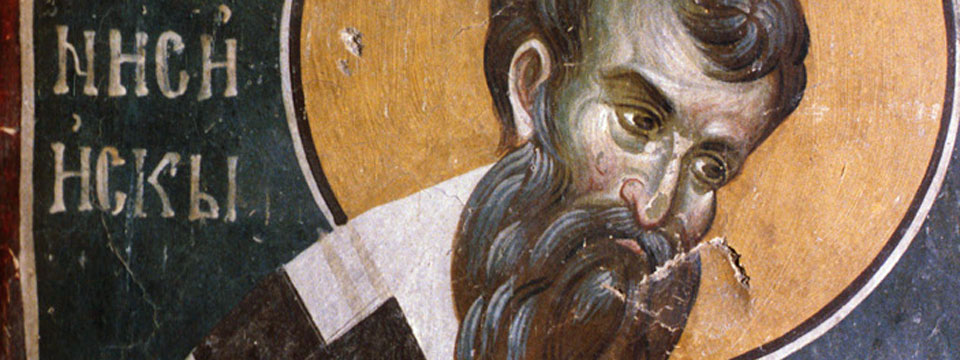The Holy Father Pope Benedict XVI has chosen a beautiful theme and title for the bull of indiction, his decree setting the course for the Year of Faith. This is the year when we celebrate the fiftieth anniversary of the opening of the Second Vatican Council on October 11th, 1962. The Year of Faith begins on that day and ends on the Solemnity of Christ the King, November 24, 2013. At the beginning of the Year of Faith the Synod of Bishops will gather to explore the New Evangelization and faith.
October 11, 2012 marks the twentieth anniversary of that fruit of the Council and great treasury of faith, The Catechism of the Catholic Church, Blessed John Paul’s gift to us all. Benedict XVI also points back to the Year of Faith 1968, announced by Pope Paul VI in 1967, for what turned out to be a year of great upheavals in the world and the Church, student revolutions and the encyclical Humanae Vitae. That year was marked by his gift to the Church, the Credo of the People of God, a compact summary of our faith that will surely be republished this year.
The title of the Holy Father’s decree, Porta Fidei, The Door of Faith, is taken from Acts 14:27. Here we read that Paul and Barnabas returned from mission work to their base in Antioch and “gathered the church together and declared all that God had done with them, and how he had opened a door of faith to the Gentiles.” The Holy Father adds: “To enter through that door is to set out on a journey that lasts a lifetime…”
Bearing in mind this lifelong journey of faith we ask: but what is faith?
Faith starts with trust
There is no single answer to that question. If you give only one answer, then you ignore other dimensions of faith that will be needed to correct or strengthen your answer. The Catechism of the Catholic Church offers a wide range of meanings of faith, and especially how faith guides our lives: faith as a human act, faith as grace, an infused virtue, faith as an assent to revealed truths, faith as the source of moral life and prayer, faith as certainty, faith and science, faith and eternal life…
However, trust, fiducia, is one basic meaning and this is at least a useful starting point. “I believe in you.” is a typical human expression of trust and there is an element of trust in all forms of faith in events and incidents in our daily lives. However the object of our trusting faith is Jesus Christ. We believe in him.
“Jesus, I trust in you!” the aspiration of the Divine Mercy, is a typical prayerful expression of a Christian’s relationship with Jesus Christ. It affirms personally that he is at the centre of a Christian’s life. Jesus Christ is not only the revealer of divine truths, the way we know who God is, but he is the object of our faith. He invites us to love him as God in flesh, because he is our only Redeemer and Saviour. Here faith includes a great sense of gratitude. Already we see that believing in Christ is not only trust in him, but a belief about him. This will become clearer when we reflect on faith as assent to revealed truths in the creeds of the Church.
The Holy Father has always affirmed the centrality of a personal faith relationship with Jesus Christ. He does it once more in Porta Fidei: “During this time we will need to keep our gaze fixed on Jesus Christ, the “pioneer and perfecter of our faith” (Hebrews 12:2): in him all the anguish and all the longing of the human heart finds fulfillment”. In this regard, the Holy Father earlier cited his beloved Saint Augustine. Commenting: “As we know his life was a continual search for the beauty of the faith until such time as his heart would find rest in God.”
In like manner, St Josemaría Escrivá again and again reminded us that our faith is grounded in Jesus Christ. He is at the centre of the life of Christians and it is the daily relationship with him in prayer that transforms our work into the work of God. He is “The Way”, he is the Christ who is always “passing by”, always calling us to follow him. Faith involves discipleship.
Therefore there is much more to faith than a religious feeling, a pleasant emotion, a subjective experience, although these elements may be there – then again, they may not. People vary. Some have a matter-of-fact faith, evident in duty and practice. Others are more emotive about faith. Some treat their faith in a private way, while others cannot stop talking about it.
Faith as trust becomes a surrender to a personal Lord and Savior, handing one’s life over to him, letting go of self. This is faith that changes life, particularly at the level of morals and prayer. For some people this is a moment of dramatic conversion. For others it begins by believing in God, which happened to CS Lewis when he was on a bus. For others it is a sense of being born again, of being forgiven and accepted. For those who pass through the Rite of Christian Initiation of Adults it takes the classical form of assent to the truth of Christ before Baptism.
We note the variety of experiences of faith in Jesus Christ, which is why the Catholic Church never requires one emotional experience, as do the “born again” evangelicals. While people may vary in the subjective dimension of faith in Christ, there is one common element – it always involves sorrow for sin and a seeking of God’s merciful forgiveness.
In her wisdom and pastoral experience, the Catholic Church understands that this faith in Jesus Christ cannot be locked into some moment or phase of conversion. For many people, faith is an ongoing lifelong relationship with God in Christ, discipleship. The door of faith leads us into a journey of faith: “To enter through that door is to set out on a journey that lasts a lifetime…” In Catholic life this life as a developing relationship with Christ happens and unfolds through the sacraments.
The sacrament of penance and reconciliation is particularly important. In the sacramental encounter with Christ, not only are sins forgiven but faith that has faded is revived. This happens in the moments of grace, in the conversional experience: repentance, confession and contrition, with the liberating words of absolution. This sacrament, derived from Baptism, is where a “conversion experience” does happen at some time or other in the lives of many Catholics. This is obvious when people return to the practice of the faith after lapsing or pass through some great trial. But it is also there, in less dramatic ways, in the sacramental practice of all believers, who are known as “the faithful.”
The mystery of grace
Here we have already entered the mystery of grace. We open the Holy Father’s door and see the glowing truth, that faith is a gift of God. Faith is a grace of the Holy Spirit, the virtue infused in baptism, together with hope and charity. This is the justifying and sanctifying grace that is revived and restored in penance.
The Year of Grace, proclaimed by the Bishops of Australia, and the Year of Faith proclaimed by Pope Benedict converge in October. But, as we see, these two themes are inseparable, grace and faith.
To say sincerely, “I believe in…” is an act made possible by grace. But through this gift I first believe in God. In Porta Fidei the Holy Father begins his message with our baptismal faith in God the Holy Trinity. This leads us into the language of faith, the words of the Church, by which we are able to express, articulate, state, affirm and profess our faith. Humans need language, and the creeds are the way the Church speaks in faith.
The creeds of the Church were evident very early in the history of Christianity, first as the simple formulae used for the profession of faith made by a catechumen just before he or she entered the waters of Baptism to be born again through the Holy Spirit. The Apostles Creed is the old Roman baptismal creed, and we still use it at the baptisms of adults and children, at Confirmation and during the Easter Vigil and Easter Season.
The creeds show us another dimension of faith, that faith is a personal assent to revealed truths. The great creed we sing or say at Mass, the Nicene Creed, focuses on God the Holy Trinity, object of our faith and, through the Holy Spirit, the source of our faith. But we should note that this assent to revealed truths includes trust, first believing in the God who cannot deceive us or be deceived. Then we believe in his Church which hands on the Deposit of Faith, from the time of the apostles.
The apostles were the witnesses to the physical Resurrection of Jesus Christ, the event that is the crux of faith. Described as the Paschal Mystery at the Second Vatican Council, the death and resurrection of Jesus in history, in a specific time and place, completes the event of God taking human nature through the Virgin Mother, the Incarnation. The Word became flesh to save us.
The creeds articulate this “salvation history”, the content of the faith of the Church. At the end of the baptismal act of faith, at Baptism and Confirmation there is an acclamation: “This is our faith. This is the faith of the Church. We are proud to profess it in Christ Jesus our Lord.”
Sensus Fidei
This “faith of the Church: leads us to the use of the terms “The Faith”. This is an objective way of summing up the whole body of Catholic truth, made up of truths revealed in the words and deeds of Jesus Christ. These truths of faith are passed on in the two sources of Divine Revelation, the Scriptures and Tradition, as the Second Vatican Council teaches in the Decree on Divine Revelations, Dei Verbum, 8-10.
The Faith is proclaimed and protected by the teaching Church, the Magisterium of the Pope and Bishops. This Catholic Faith is the faith of millions. As the Holy Father says: “Profession of faith is an act both personal and communitarian. It is the Church that is the primary subject of faith…” He then links this to Baptism, that is, to grace.
Christianity is not a one-to-one individualistic religion, which is why the Holy Father affirms: “A Christian may never think of belief as a private act.” Certainly at the core of a Christian’s experience in the lifelong journey of faith we find some form of a personal relationship with Christ the Lord. At the same time this is part of the wider communal faith, professed and shared by God’s People, the Faith of the Church, the faith of a people who have a sensus fidei a “sense of faith”. This deep appreciation of the faith is a kind of instinctually shared belief, which happens to be one of the secondary benchmarks for orthodoxy. The Second Vatican Council affirmed it in Lumen Gentium 12 and 35, therefore endorsing one of the insights of Blessed John Henry Newman.
He studied the Arian heresy, which flourished in the fourth and fifth centuries, and note that even when bishops wavered, the lay faithful had a discriminatory sense that separated error from truth.
When we go through the propositions of the creed we say we believe in them. So they are not simply truths “over there” on some library shelf or “kept in a file in my computer”. These are truths involving us, our lives, our past, present and future existence as the faithful. This is clear in the last phrases of the creed when we profess our faith in mysteries that involve us now and certainly will involve us after we die.
Moreover, the support of other Christians further underlines the interplay between personal faith and the faith of the Church. The people around us at Mass inspire us, or they should inspire us, in our common journey of faith. The Holy Father quotes Saint Augustine: “Believers strengthen themselves by believing”. The discipleship of faith is a shared journey.
In a more striking way, great heroes and heroines of faith, saints, martyrs and confessors, urge us on in the journey of faith, where they have gone ahead of us, before us, into the Kingdom where faith becomes knowledge and glory.
The faith of the witnessing Church on pilgrimage, pressing forward amidst persecutions, was set out by the Fathers of the Second Vatican Council in Lumen Gentium, 8, which is cited by the Holy Father. He adds: “The Year of Faith, from this perspective, is a summons to an authentic and renewed conversion to the Lord”.
More philosophical dimensions of faith emerge when we reflect on the words, “I believe that…” In his work The Grammar of Assent, Blessed John Henry Newman reflected deeply on “I believe that…” From the Latin term for “that”, ille, he came up with what he called the “illative sense” as a way of understanding how we make assent to revealed truths.
However problems arise when you isolate fiducia, faith as trust, and separate that personal subjective form of faith from the faith of the Church and from the infused gift of faith in Baptism. This happens when some people say “Jesus, yes, the Church, no.” An individualistic faith in Christ is a partial faith. This is also where Martin Luther went wrong by teaching “justification by faith alone “ — just believe in Jesus and trust and you are saved. This is the kind of simplification of truth which unfortunately leads people astray.
Faith and Scripture
Saint Paul certainly teaches “For by grace you have been saved through faith; and this is not your own doing, it is the gift of God – not because of works, lest any man should boast.” Ephesians 2: 8-9. This raises the issue of faith and good works, or good deeds. Luther said that good deeds are not necessary, contradicting the Letter of Saint James. He took up Saint Paul’s message that we are saved by faith, but he added “alone”. And that with that little word he sidelined the Church and sacraments, which effectively eliminates core teachings of Saint Paul about Baptism, the Church as the Body of Christ and the faith practices of the Church.
Faithful to the whole content of the Scriptures, and not to one man’s private interpretation, the Council of Trent insisted that we are saved by grace through faith, but that good works are also there in this process, for good works are infused with grace. The grace of God is given to us to work within us, to bring us the justifying goodness of God and to sanctify us, not just to be an external shield from divine wrath while we remain corrupt, as Luther claimed.
Because they hear an over-emphasis on subjective faith, fiducia, some people believe Christians call for a blind faith, a leap into the dark. This seems to be the way media evangelists present faith. “Just believe…” But if faith involves the whole person, then the human reason cannot be excluded.
The relationship between faith and reason is also underlined by the Holy Father in Porta Fideiwhen he points back to the masterly encyclical of Blessed John Paul II, Fides et Ratio, which unraveled the interdependence of faith and reason. He says: “To a greater extent than in the past, faith is now being subjected to a series of questions arising from a changed mentality which, especially today, limits the field of rational certainties to that of scientific and technological discoveries. Nevertheless the Church has never been afraid of demonstrating that there cannot be any conflict between faith and genuine science, because both, albeit via different routes, tend towards the truth.”
In this perspective I would underline the urgent need for more and better apologetics today, for fresh, clear and attractive explanations of the faith that provide reasons for the faith that is within us. Faith is also to be understood as divine enlightenment, being able to see the truth, which means being able to see through what is false in the world around us. This Year of Faith is thus an opportunity to focus on this apostolate of apologetics. The new atheists, largely by cynical satire and ridicule, are recruiting many of the young, whose grasp of reason in our times is, to put it mildly, rather limited.
Deepening of faith as we grow in faith, we turn to Our Lady. In Porta Fidei she is the model of faith, beginning with her trusting consent at the Annunciation. We join her, through our prayer, the grace of the sacraments and works of charity, and through the exercise of reason enlightened by the Holy Spirit.
The Holy Father has opened the door. Through it we can see his vision. Let us enter the Year of Faith by sharing the vision and taking up the New Evangelization with vigor and confidence.
